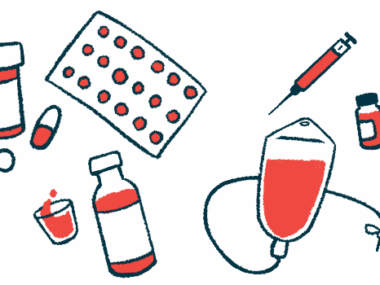#NACFC2021 – Hypertonic Saline ‘Effective, Safe, Cheap’ Way to Help Young Lungs
Written by |

Use of inhaled hypertonic saline can lessen cystic fibrosis (CF)-related lung damage in young children with the disease, data from a clinical trial indicates.
Based on these finding, “we can conclude that hypertonic saline is an effective, safe, and cheap treatment option for preschool children with CF,” said Harm Tiddens, MD, PhD, a professor at Erasmus Medical Center in the Netherlands.
Tiddens shared trial results at the 2021 North American Cystic Fibrosis Conference in the talk, “The effect of inhaled hypertonic saline on structural lung disease in preschool children with cystic fibrosis. The SHIP-CT study.”
Hypertonic saline is salt water, with a higher concentration of sodium chloride (a common salt) than is naturally found in the body. It is established that inhaling hypertonic saline can help to hydrate the airways and clear mucus.
The Saline Hypertonic in Preschoolers (SHIP) study (NCT02378467) was a 48-week clinical trial that tested 7% hypertonic saline against 0.9% isotonic saline (which has the same concentration of salt found in body fluids) in children with CF, ages 3 to 5.
Data from the SHIP trial showed that twice-daily treatment with hypertonic saline improved lung function. However, the treatment’s effects on CF lung disease and the structural changes to the airways it causes were not investigated.
“Cystic fibrosis lung disease is characterized by early inflammation, infection, and structural lung abnormalities,” Tiddens said.
A separate study, called SHIP-CT (NCT02950883), was opened to also test inhaled 7% hypertonic saline against 0.9% isotonic saline in preschool children twice daily for 48 weeks. But here, children ages 3 to 6 also underwent chest CT scans to image the lungs at its start and end. The children were given training on how to hold their breath during these scans, in order to minimize anxiety and best ensure high-quality images.
These images were then analyzed using a software called PRAGMA-CF, which is “basically an annotation system based on morphometric [the study of the shape of organs] principles,” according to Tiddens. These analyses were used to calculate a “percent disease” score, essentially reflecting areas of the lung that showed clear evidence of damage.
This disease score, adjusted for scores prior to treatment, was compared between the 49 children in SHIP-CT given hypertonic saline, and the 55 given the control isotonic saline. Both groups were roughly even by sex, with an overall median age of just under 5, and nearly all were white.
Most children in the study had relatively mild structural lung disease at the start, results showed, with little change over the course of the trial. However, “there [is] a high number of patients that have moderate to severe changes” in lung structure, Tiddens said.
These changes were more pronounced in the isotonic saline group, where lung disease appeared to be “progressive over the 48 weeks’ study duration,” he noted.
Statistical analyses confirmed that children given hypertonic saline were significantly less likely to have structural lung damage. At the trial’s end, these patients had a mean 0.67% less diseased lung volume.
Other analyses of specific forms of lung damage — namely bronchiectasis and trapped air — showed “exactly the same pattern,” with hypertonic saline significantly outperforming the isotonic control, Tiddens said.
Children given hypertonic saline also tended to have a better lung clearance index (LCI) at the end of the trial, though the difference was not statistically significant between these groups in all analyses. LCI is basically a measure of how quickly the lungs can get new air in, and old air out.
Collectively, the imaging and LCI results are “in line with” earlier data from the SHIP trial showing an improvement in lung function, and “a positive effect of inhaled hypertonic saline,” Tiddens concluded.
Hypertonic saline treatment, overall, was tolerated well in the SHIP-CT study, with few side effects attributed to treatment.
“Hypertonic saline treatment is considered safe in general, and [results from SHIP-CT] supported that,” Tiddens said. He also noted that four life-threatening events were documented in the isotonic control group, and no such events were recorded among children given hypertonic saline.
Editor’s note: The Cystic Fibrosis News Today team is providing coverage of the virtual 2021 North American Cystic Fibrosis Conference (NACFC) Nov. 2–5. Go here to see the latest stories from the conference.







